Telemedicine statistics: This shows the use of telemedicine and virtual treatment is 28 greater than before the COVID-19 pandemic, and both service providers and patients are happy and satisfied with their experiences.
We’re living in the golden age of technology, specifically – smart technology. Technological advancements in the last few decades have made people’s lives easy.
To show you just how advanced technology is emerging in healthcare and personal health, we’ve prepared telemedicine statistics for you.
Table of Contents
- History of Telemedicine
- International Telemedicine Usage Statistics
- Health Service Telemedicine Statistics
- Willing to Use Telemedicine Service Statistics
- Most Appealing Aspects
- Telemedicine Market Size Forecast 2022-2032 Statistics
- Online Doctor Consultations – Asia
- Region Wise Telemedicine Statistics
- Popular Telemedicine Service Providers Statistics
- COVID-19 Impact on Telemedicine Statistics
- Challenges in the Adoption of Telehealth Statistics
- Recent Developments
- Conclusion
- FAQ
History of Telemedicine
In the 1950s and 1960s, the US space agency NASA developed telemedicine technology to monitor the health of astronauts in space. This involved using biotelemetry to transmit physiological data from space to Earth for real-time monitoring of health by healthcare professionals.
What is Telemedicine?
Telemedicine is a healthcare service that uses telecommunication technology to provide clinical care to patients remotely. This telemedicine service uses video conferencing, mobile apps, messaging platforms, and other communication technologies that allow doctors and other healthcare professionals to provide medical diagnoses.
How popular is telemedicine in the current era?
In the current generation of technology, telemedicine is a becoming common part of modern healthcare services, providing a variety of applications in primary care, mental health, and specialist consultations. Telemedicine is gaining popularity as an effective tool for delivering healthcare services to remote and underserved communities, which helps improve patient access to care by reducing healthcare costs.
International Telemedicine Usage Statistics
- In 2022, the US- 50% and Sweden- 58% had the highest percentage of medical practices that offer online services such as appointments, prescription refills, viewing test results, and viewing visit summaries.
- The US showed a 154% increase in telehealth usage in the first quarter of the year 2020.
- About 2,720 million participants rated telemedicine in the COVID-19 pandemic.
- 70% of medical professionals rated telemedicine in the COVID-19 pandemic.
- Asia Pacific region showed a 52% increase in telehealth access to primary physicians/general patient services from 4% to 56%.
(Source: The Commonwealth Fund, 2022, Willis Towers Watson, 2022)
Take advantage of our unbeatable offer - buy now!

Who Uses Telemedicine and Why?
- 80% of consumers have used telemedicine at least once.
- 76% of people over the age of 55 have used telemedicine.
- 73% of people who live in rural areas use telemedicine.
- 98% of transgender patients say they have used telemedicine.
- 61% of patients prefer to use telemedicine for prescription management and to receive care for minor illnesses (51%).
- 96% of telepsychiatry patients are satisfied with virtual mental healthcare.
(Source: Rock Health, PubMed)
The adoption of telemedicine has reached up to 80% overall, which is becoming the most preferred channel for prescription care and minor illness issues.
- In our 2022 Survey, 80% of all respondents reported having accessed care via telemedicine at some point in their lives, up 8pp from 72% in 2021.
- Users of telemedicine aged more than 55+ have increased from 64% to 76% in 2022.
- The use of telemedicine by respondents living in rural areas increased from 60% to 73% in 2022.
- The use of telemedicine by respondents without health insurance increased from 37% to 50% in year2022.
- Telemedicine use also increased among women, with 82% of women respondents reporting having used telemedicine.
- 82% of Hispanic respondents reported telemedicine use.
- 61% of respondents reported preferring telemedicine and minor illness care 51% of respondents reported preferring telemedicine.
- 71% of respondents with 4+ current prescriptions at the time.
(Source: Rock Health)
Who are Today’s Telemedicine Holdouts?
- 20% of the respondents reported no prior telemedicine use.
- 44% of respondents indicated that they prefer to discuss health in person.
- 57% of people use live phone telemedicine.
- 48% of individuals prefer health apps or websites for prescriptions.
- 43% of respondents prefer emails.
- 36% of users prefer text messages for a prescription.
(Source: Rock Health)
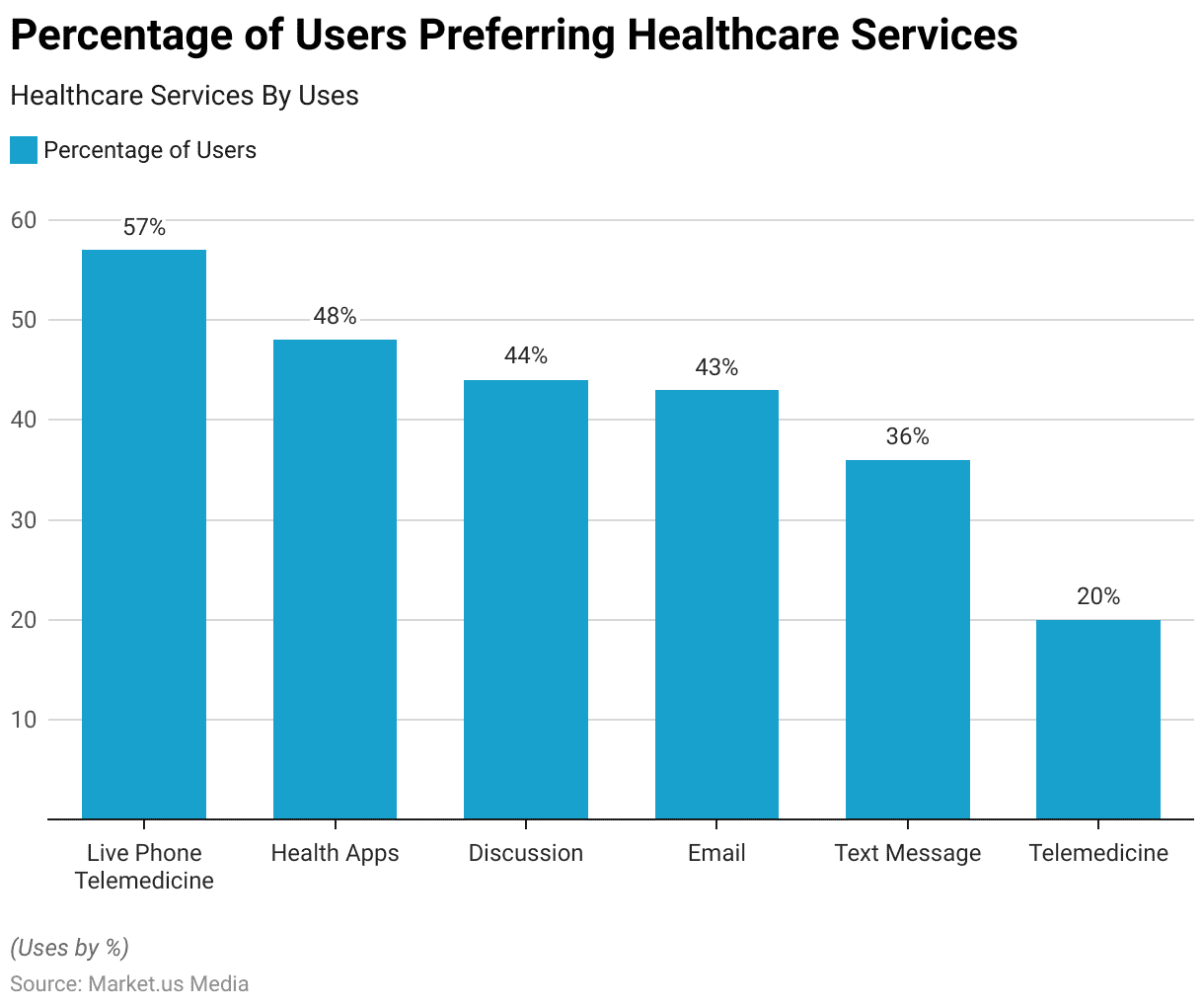
Health Service Telemedicine Statistics
Telemedicine plays an important role in various services such as appointments to diagnose common illnesses and infections, follow-up visits after procedures or hospitalizations, talk therapy, management of chronic conditions, and more.
Also, telehealth is becoming more popular and acceptable by clinicians and patients, some services are only appropriate for person actual visits, because of clinical conditions or provider’s preferences.
43% of respondents don’t know if telehealth services were offered by their healthcare providers pre-pandemic
Before the COVID-19 pandemic outbreak, 435 respondents reported that they didn’t know that healthcare professionals provide telehealth services. 5 in 1 respondent only knows about these services.
- 19% Yes, telehealth services were available pre-pandemic.
- 43% I don’t know if telehealth services were available pre-pandemic.
- 38% No, telehealth services were unavailable pre-pandemic.
(Source: singlecare)
Consumers’ opinions about their healthcare professionals providing telemedicine services.
- 58% of respondents say that yes, their provider currently offers telehealth services
- 26% I don’t know if my provider currently offers telehealth services
- 16% No, my provider does not currently offer telehealth services.
(Source: singlecare)
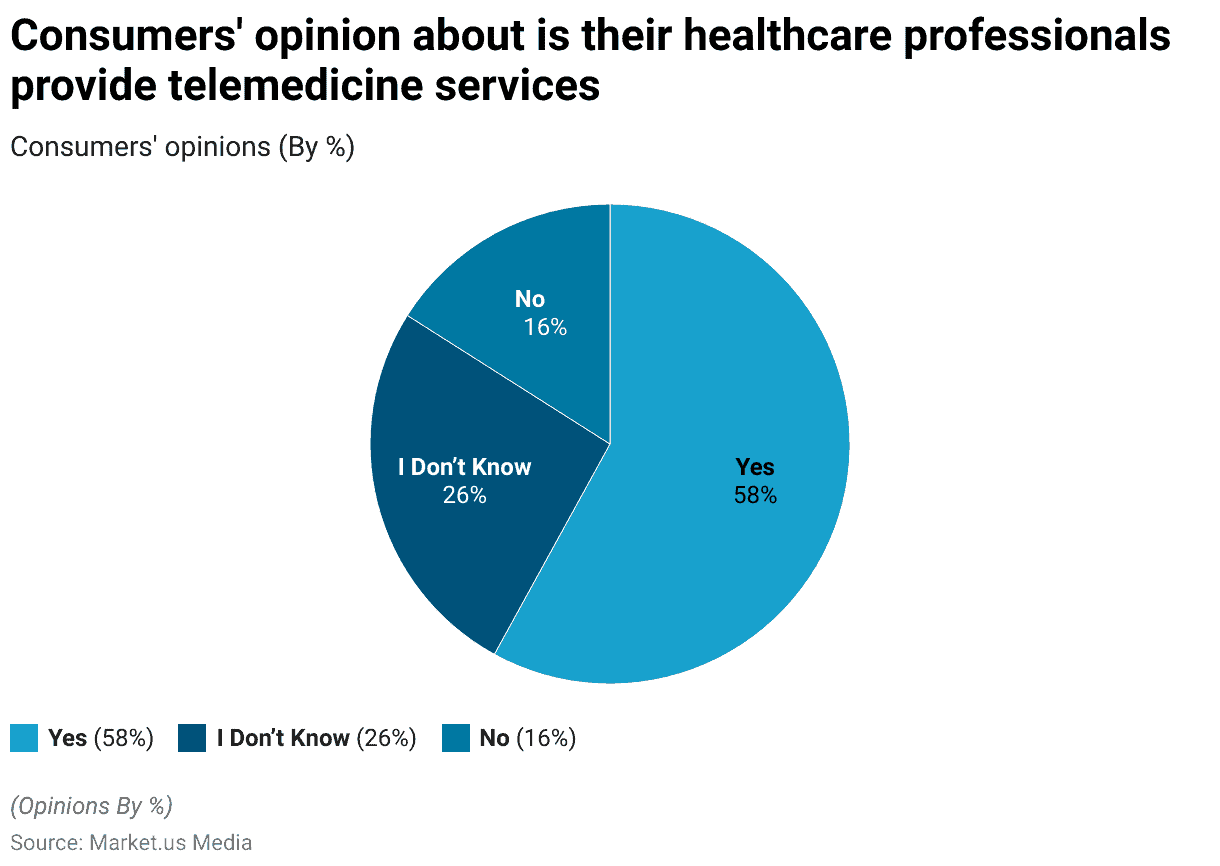
74% of respondents are open to using telehealth services
- 40% Yes, I have used telehealth services in the past.
- 34% Yes, I have not used telehealth services, but I would consider it in the future.
- 21% No, I have not used telehealth services in the past and would not consider it in the future.
- 5% No, I have used telehealth services in the past and would not do so again.
(Source: singlecare)
Willing to Use Telemedicine Service Statistics
The majority of respondents reported being willing to use telehealth services for common illnesses and infections and to reduce hospital visits.
- 69% of respondents use telehealth services for common illnesses and infections.
- 66% of respondents’ follow-up hospital visits.
- 49% follow talk therapy.
- 44% of respondents use telehealth for the management of chronic diseases.
- 24% of people prefer specialist visits.
- 3% of respondents prefer other services.
(Source: singlecare)
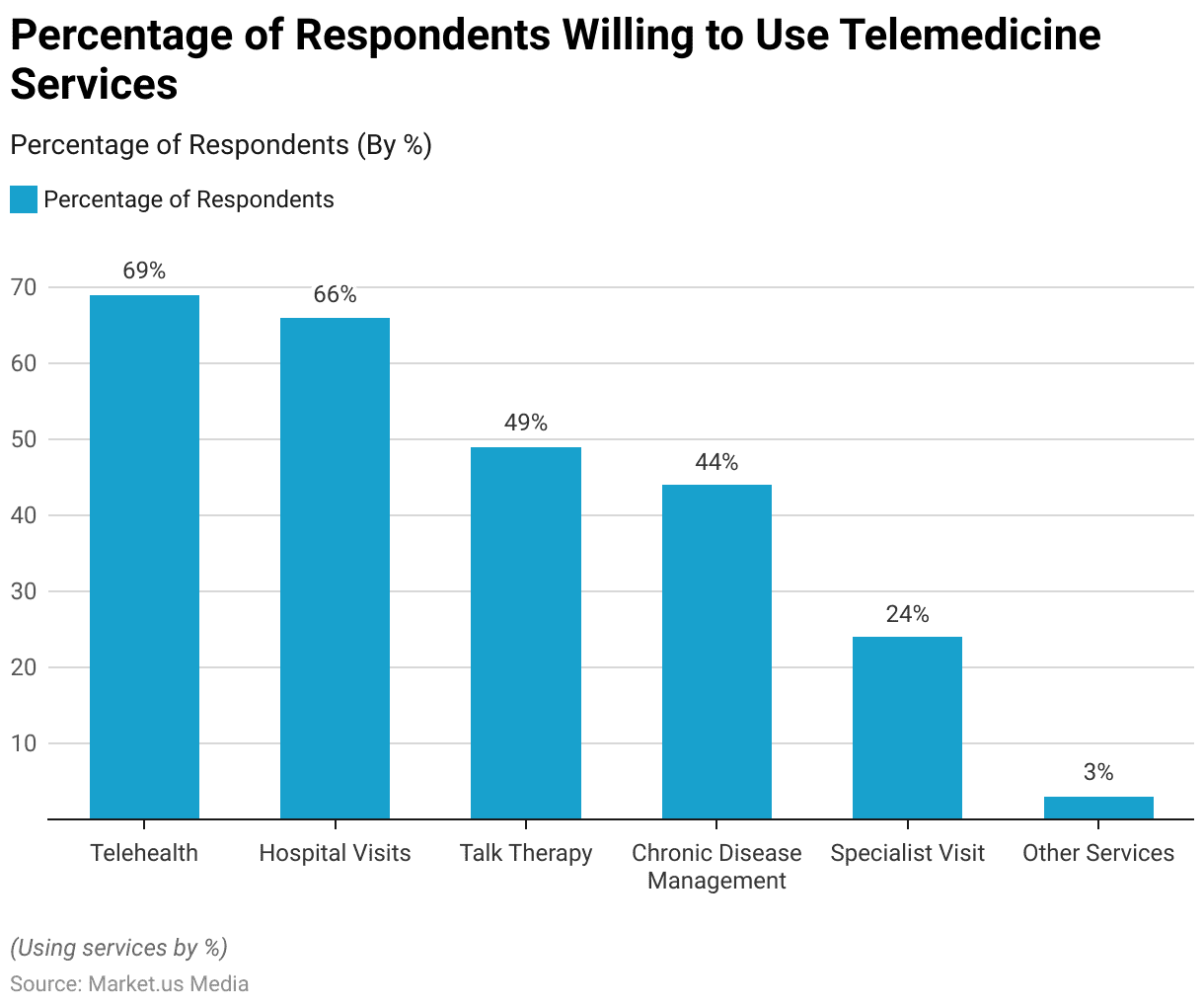
Most Appealing Aspects
Below are statistics on Saving time, not having to travel, and appointment availability
In a 2017 study, it was found that a total of 121 minutes were spent on each in-person visit. This time includes time spent traveling, prescriptions, and waiting. Telehealth eliminates the traveling time, and waiting time by 31%.
- 70% of users don’t have time to travel.
- 44% of respondents said that telehealth saves money.
- 39% I feel more comfortable in my own home than a doctor’s office.
(Source: singlecare)
Telemedicine Market Size Forecast 2022-2032 Statistics
- The telemedicine market has grown significantly in recent years.
- The global telemedicine market size is expected to be worth around USD 590.9 Bn by 2032
- The market holds a revenue of USD 63.5 Bn in 2022.
- The global telemedicine market is growing at a CAGR of 25.7% during the forecast period from 2022 to 2032.
- 45% of users prefer product components in telemedicine.
(Source: Market.us)
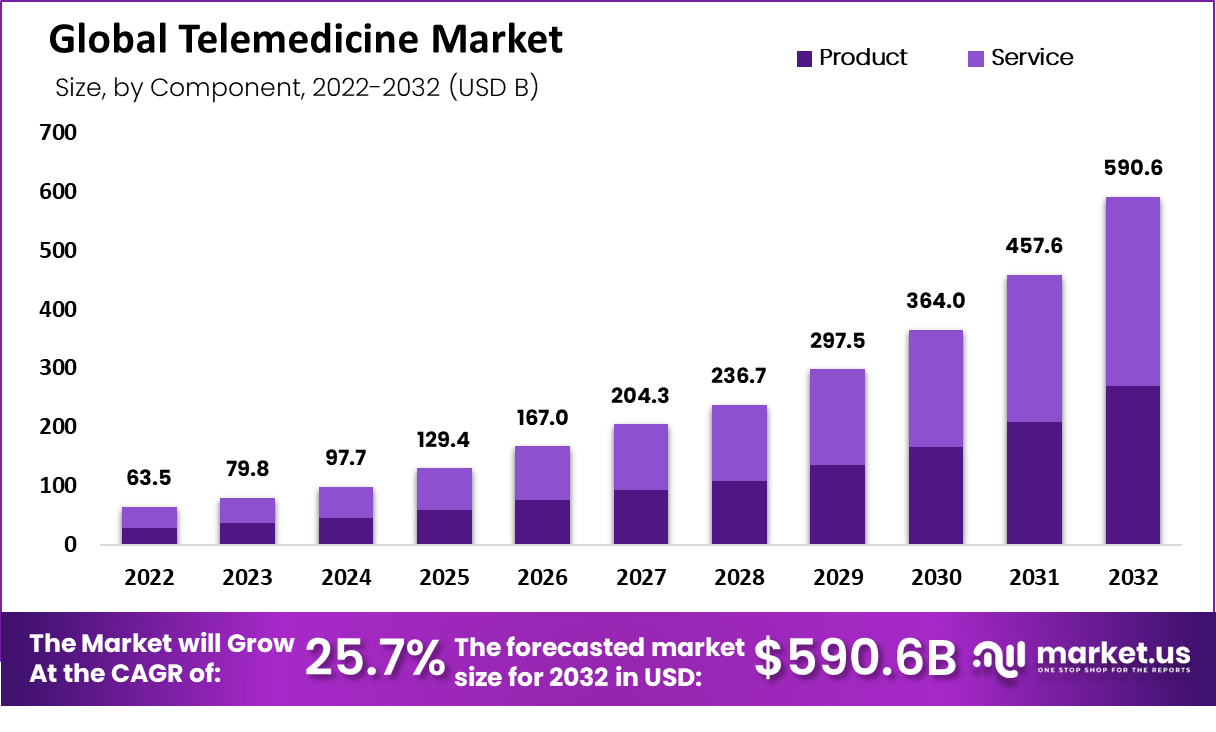
Online Doctor Consultations – Asia
- Revenue in the Online Doctor Consultations segment is projected to reach US$12.80bn in 2023.
- Revenue is expected to show an annual growth rate (CAGR 2023-2027) of 10.81%, resulting in a projected market volume of US$19.30bn by 2027.
- User penetration will be 1.39% in 2023 and is expected to hit 1.56% by 2027.
- The average revenue per user (ARPU) is expected to amount to US$204.00.
(Source: Statista)
Region Wise Telemedicine Statistics
North America
North America is the leading country in the global telemedicine market.
- 52% of American adults reported usage of telemedicine through live video calls with their healthcare providers.
- Revenue from digital health is projected to reach USD 26.59 billion at the end of the year 2023.
- Revenue is expected to show an annual growth rate of 7.28%.
- Telemedicine use increased with age and was higher among women (42.0%) compared with men (31.7%).
- The percentage of adults who used telemedicine increased with education level and varied by family income.
(Source: Statista, cdc.gov)
Online Doctor Consultations Statistics- North America
- The online doctor consultation segment is expected to reach US$5.88bn in 2023.
- Revenue of this segment is expected to show an annual growth rate of 5.36% and is expected to grow at revenue of US$7.25bn by 2027.
- User penetration will be 2.72% in 2023 and is anticipated to increase to 2.89% by 2027.
- The average revenue per user (ARPU) is expected to amount to US$0.42k.
(Source: Statista)
North America Telemedicine Statistics by Gender and Age in the Last 12 Months
- In the past 12 months 37% of adults aged 18 and above used telemedicine services.
- 42% of women used telemedicine services.
- 31.7% of men used telemedicine services.
- 29.4% of individuals aged 18-29 years used telemedicine.
- 35.3% of people aged 30-44 years use telemedicine services.
- 38.9% of people aged 45-64 years use telemedicine services.
- 43% of people aged 65 and above use telemedicine services.
(Source: cdc.gov)

India
Telemedicine market size forecast from 2019- 2025 in India
- The telemedicine market was valued at 830 million U.S. dollars in 2019.
- The revenue share of the market was USD 1,865.9 million in 2022.
- The market is expected to grow at a revenue of USD 4,194.7 million in 2025.
- The market is growing at a CAGR of 31% in India.
(Source: Statista)
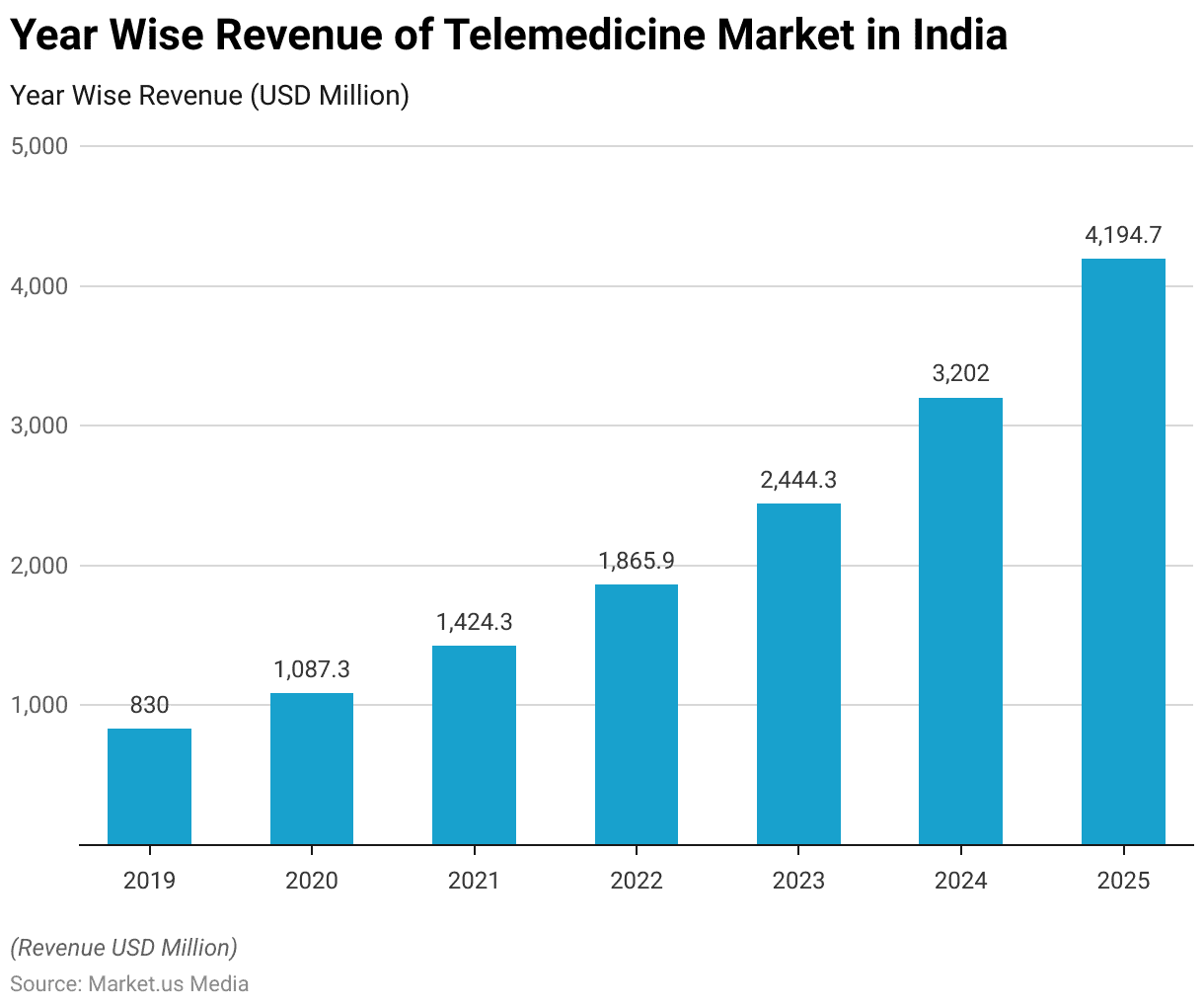
Online Doctor Consultations Statistics of India
- Revenue in the Online Doctor Consultations segment is projected to reach US$133.0m in 2023.
- Revenue is expected to show an annual growth rate of 21.21% from 2023-2027, resulting in a projected market volume of US$287.10m by 2027.
- User penetration will be 0.14% in 2023 and is expected to grow 0.20% by 2027.
(Source: Statista)
Europe
Online Doctor Consultations of Central & Western Europe Statistics
- Revenue in the Online Doctor Consultations segment is expected to reach US$2.83bn in 2023.
- Revenue is expected to show a CAGR of 6.63% by 2027.
- User penetration will be 2.49% at the end of the year 2023 and it is expected to grow to 2.74% by 2027.
- The average revenue per user is expected to amount to USD 0.34K.
(Source: Statista)
Online Doctor Consultations Statistics- Eastern Europe
- Revenue in the Online Doctor Consultations segment is projected to reach US$352.40m in 2023.
- Revenue is expected to show an annual growth rate (CAGR 2023-2027) of 9.48%, resulting in a projected market volume of US$506.30m by 2027.
- User penetration will be 1.02% in 2023 and is expected to hit 1.15% by 2027.
- The average revenue per user (ARPU) is expected to amount to US$141.60.
(Source: Statista)
Popular Telemedicine Service Providers Statistics
Teladoc Health
- Teladoc Health is the leading company in the telemedicine industry and provides virtual medical care services to patients around the world.
- The fourth quarter revenue grows by 15% year-over-year to $637.7 million and full-year revenue grows by 18% year-over-year to $2,406.8 million.
- A total of 1.3 M people visit teladoc.com.
- The revenue of Teladoc Health is $610 – $625 million in 2023.
(Source: teladochealth)
Amwell
Amwell is another major player in the telemedicine market, that offers a range of virtual care services to patients across the globe. The company provides video visits, remote monitoring, and a variety of other tools to help patients manage their health.
- The annual revenue of Amwell is $ 200.0M – $500.0M.
- A total of 498.9 K people visited the Amwell site last month.
- amwell.com’s audience is 45.45% male and 54.55% female.
- The largest age group of visitors is 25-34 years old.
(Source: Amwell)
Doctor On Demand
Doctor on Demand is a telemedicine company that provides virtual medical care services to patients across the United States.
- Doctor on Demand observed tremendous growth in the volume of visits during the COVID-19 pandemic, with total visits volume up to 59%.
- All visits among urban residents peaked at 58% above baseline, whereas visits among rural residents peaked at 64% above baseline.
- The proportion of patients new to the telehealth platform increased from 40% in February 2020 to 53% in April 2020.
(Source: fierce healthcare)
MDLIVE
MDLIVE is a telemedicine company that provides virtual medical care services to patients across the United States.
- A significant number (78%) of MDLIVE behavioral health patients reported clinical improvement after just three sessions with an MDLIVE therapist.
- 93% of MDLIVE dermatology patients reported the resolution of their clinical issue during their first consultation.
- Among patients utilizing MDLIVE’s primary care services, 68% had at least one chronic disease identified via the service’s wellness screenings.
(Source: mdlive.com)
American Well
American Well is a telemedicine company that provides virtual medical care services to patients around the world.
- American Well has a market cap or net worth of $565.66 million. The enterprise value is $41.16 million.
- American Well has 282.83 million shares outstanding. The number of shares has increased by 7.94% in one year.
(Source: stockanalysis.com)
COVID-19 Impact on Telemedicine Statistics
The pandemic surged the demand for telemedicine services because patients looking to avoid in-person visits to healthcare. Many healthcare providers have rapidly expanded their telemedicine offerings, due to the pandemic and added new services of virtual care.
76% of consumers prefer emergency room visits or ambulance calls in the middle of the night while 24% of consumers said that they would choose telehealth other than hospital visits during the pandemic.
(Source: americanwell)
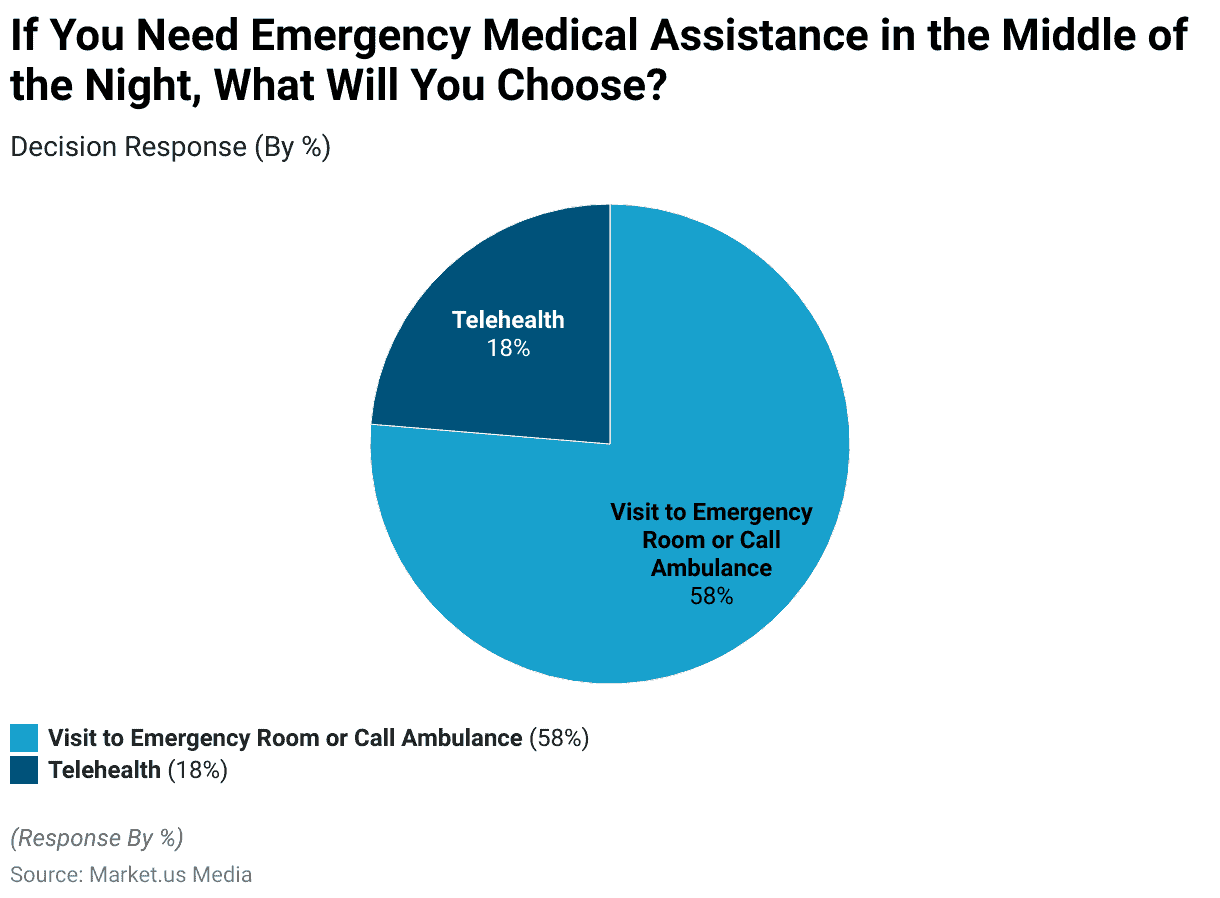
- 58% of surveyed physicians in 2021 view telehealth more favorably.
- In January 2019, 82% of individuals preferred video visits.
- 69% of individuals rated their virtual visit a 9 out of 10.
- In July 2019 found that 81% of respondents preferred a provider who offered telemedicine services.
- Usage of telehealth has doubled from 14% in 2016 to 28% in 2019.
- In the last five years, telemedicine has grown by 44%.
- 66% of consumers are eager to use telehealth, and 8% have tried it in 2019.
- Only 20% of consumers willing to use telehealth said they would use it to see a pediatrician for their child.
(Source: singlecare, ama-assn, GlobalMed)
Consumers’ Willingness by Income, Education, and Employment Status
Age plays an important role in consumers’ willingness in telemedicine.
- Consumers with higher household incomes are more likely to open using telehealth services.
- Willingness to use telehealth also increases with education level.
- 69% of consumers who have graduated college are willing to use telehealth.
- 61% of consumers with high school or diplomas are willing to use telemedicine services.
- Consumers who are currently employed are also more likely to use telehealth (72%).
- 57% of consumers who are unemployed willing to use telehealth services.
(Source: americanwell)
Telemedicine Statistics By Consumer Willingness

Challenges in the Adoption of Telehealth Statistics
Most of the consumers are willing to use telehealth, while 34% of people said they are not willing to use the technology because.
- 51% of consumers said they use mobile health apps.
- 72% of millennials prefer to use health apps.
- 25% of seniors have also used a health app.
- 40% of consumers aged 55-64 and 27% of seniors are using their health plan’s mobile app.
- 83% of seniors reported they use a blood pressure monitor.
- 46% of millennials also utilize blood pressure monitoring devices.
(Source: americanwell)
Consumers are Still Delaying Needed care
- 70% of consumers say they have delayed seeking care for a health problem.
- 84% of millennials have delayed seeking care versus 55% of seniors.
- 41% of millennials reported delaying care for a serious health issue, compared to 17% of seniors.
- Consumers within the 45-54 and 65+ age groups were the most likely to delay care because it takes too long to see a doctor.
- The cost was also a major reason why consumers delayed care.
(Source: americanwell)
Recent Developments
Acquisitions and Mergers:
- TeleHealth Innovations acquired VirtualCare Solutions for $120 million, consolidating their telemedicine platforms and expanding their reach in remote healthcare delivery.
- MedTech Solutions merged with TeleClinic Inc., creating a comprehensive telemedicine network with combined annual revenues projected to exceed $500 million.
New Product Launches:
- HealthConnect launched a mobile telemedicine app offering virtual consultations with healthcare providers, aiming to capture 20% of the telehealth app market within the first year of release.
- TeleMedX introduced a telemonitoring system for remote patient monitoring, enabling real-time tracking of vital signs and medication adherence, with a target of deploying 10,000 units to healthcare facilities nationwide.
Funding Rounds:
- TeleDoc received $50 million in Series C funding led by Healthcare Investment Group ABC to expand their telemedicine platform’s capabilities and enhance user experience, targeting a 40% increase in active users within the next year.
- RemoteCare secured $30 million in venture capital funding from Tech Investors XYZ to accelerate product development and market expansion efforts, aiming to penetrate underserved rural areas and emerging markets.
Consumer Trends:
- Rising demand for convenient and accessible healthcare services fueled the adoption of telemedicine platforms, with teleconsultation volumes increasing by 40% compared to the previous year.
- Remote patient monitoring devices and wearable health trackers gained popularity, with sales volumes growing by 35% and 45%, respectively, as patients embraced proactive healthcare management from the comfort of their homes.
Regulatory Developments:
- Regulatory bodies implemented policies to support telemedicine adoption, including reimbursement parity laws and licensure reciprocity agreements, facilitating cross-border telehealth services and improving patient access to virtual care options.
Conclusion
Telemedicine Statistics – Telemedicine is a vastly growing industry in the current era of technology that allows healthcare providers to provide medical care to patients remotely using technology such as videoconferencing, remote monitoring, and mobile health apps. Telemedicine has the potential to improve access to care, reduce costs, and improve patient outcomes, particularly in rural or underserved areas.
The COVID-19 pandemic surged the adoption of telemedicine by healthcare providers and patients, as it offers a safe and convenient way to receive medical care while minimizing the risk of exposure to the coronavirus. The COVID-19 pandemic has also led to regulatory changes and technology improvements in the telemedicine industry.
Leading companies in the telemedicine market include Teladoc Health, Amwell, Doctor on Demand, MDLIVE, American Well, Telus Health, and Babylon Health. The demand for virtual medicine care is increasing, we can expect to see more competitive companies enter the industry and further create lucrative growth opportunities in the market during the upcoming years.
FAQ
Telemedicine is a healthcare delivery service that uses telecommunication technology to provide clinical care to patients from a remote location. These services use video conferencing, mobile apps, messaging platforms, and other communication technologies to enable doctors and other healthcare professionals to provide medical consultations, diagnosis, treatment, and monitoring of patients from a distance.
The pandemic surged the demand for telemedicine services as patients seek to avoid in-person visits to healthcare facilities. Many healthcare providers have rapidly expanded their telemedicine offerings in response to the pandemic, adding new services and increasing access to virtual care.
North America is the leading country in the global telemedicine market.
In 2022, the global telemedicine market was valued at USD 83.4 billion and it is expected to reach a revenue of USD 327 billion by 2030 with a CAGR of 19%.
Discuss your needs with our analyst
Please share your requirements with more details so our analyst can check if they can solve your problem(s)



